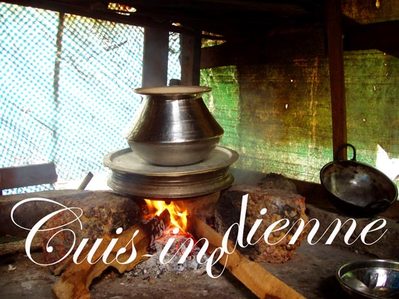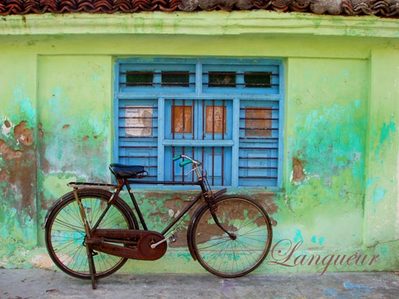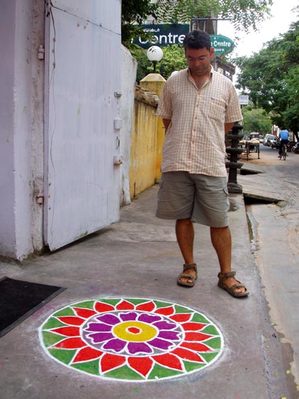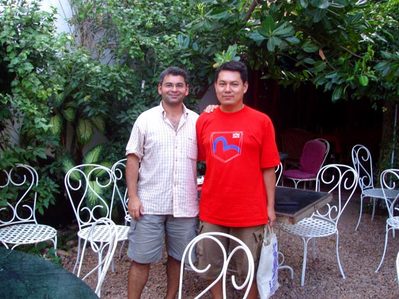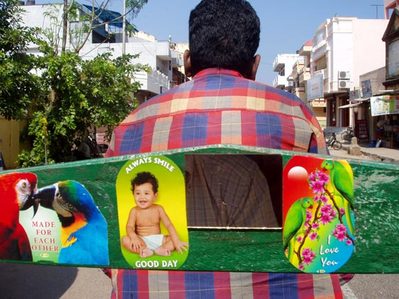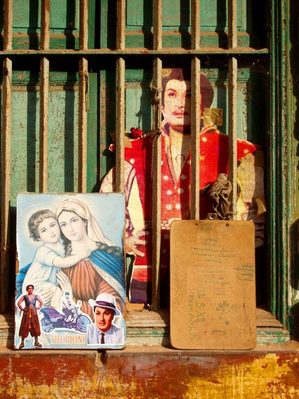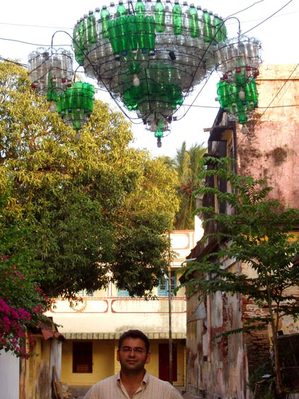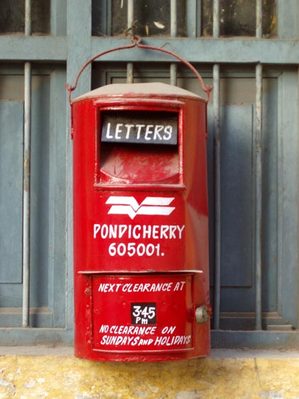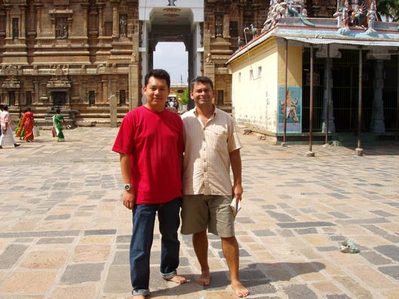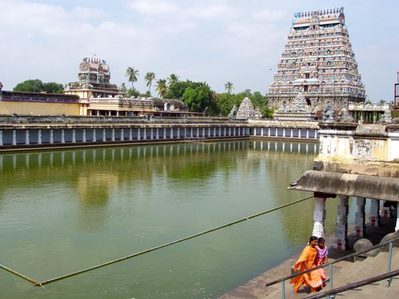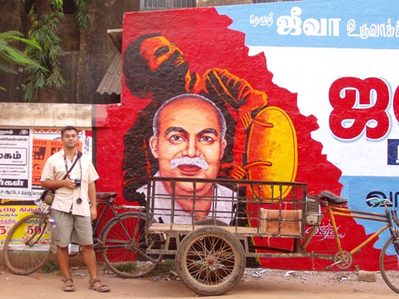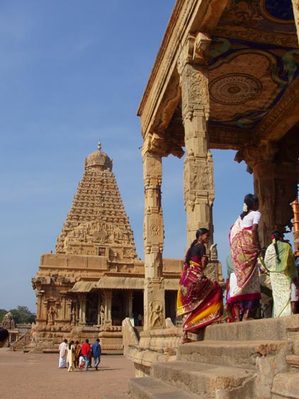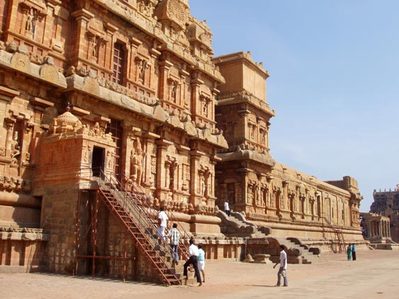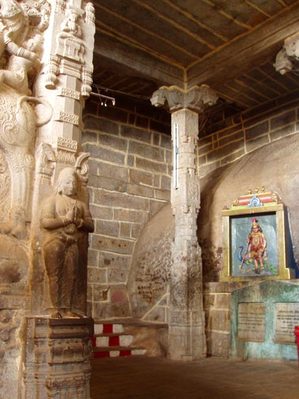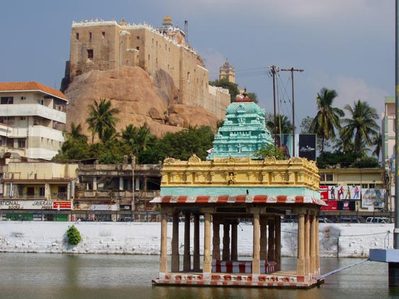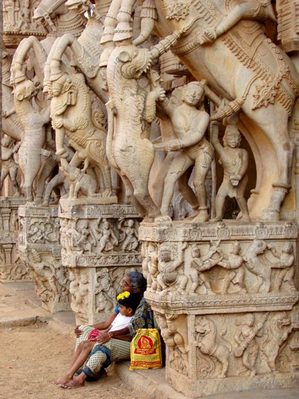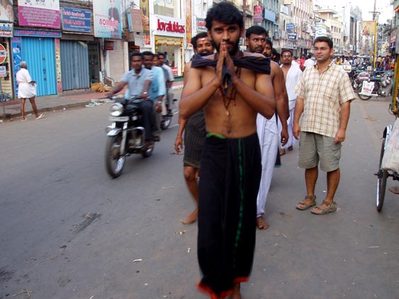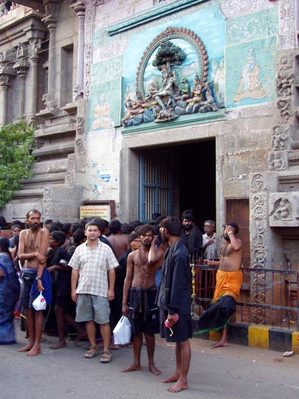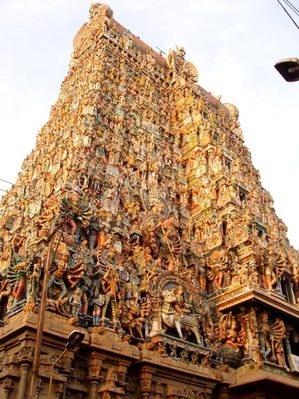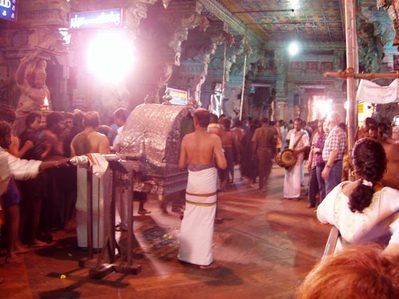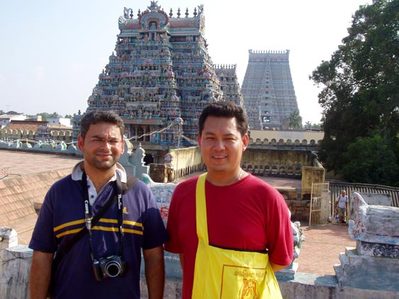 Nous sommes à Trichy, à l'instant de faire la rencontre de Paulette et Martine, qui attendaient leur guide en français pour la visite du temple.
Nous sommes à Trichy, à l'instant de faire la rencontre de Paulette et Martine, qui attendaient leur guide en français pour la visite du temple.
The Sri Ranganathaswamy Temple in Srirangam, Tamil Nadu India is a Hindu temple dedicated to Lord Ranganatha, a reclining form of Lord Vishnu. It is the first and foremost among the 108 Divya Desams, the holy abodes of Lord Vishnu. The temple occupies an area of 156 acres (6,31,000 m²) with a perimeter of 1,116m (10,710 feet) making it the largest temple in India and one of the largest religious complexes in the world. Actually, Srirangam temple can be easily termed as the biggest functioning Hindu temple in the world (it's termed as biggest "functioning" because Angkor Wat is the biggest but non-functioning Hindu temple in the world). The temple is enclosed by 7 concentric walls and the total length of these seven walls is 32,592 feet or over six miles enclosed by 21 Gopurams (Towers). Among the marvels of the temple is a "hall of 1000 pillars" (actually 953). Though, the term Kovil is generically used in Tamil to signify any temple, for many Vaishnavas the term Kovil exclusively refers to this temple, indicating its extreme importance for them. The presiding deity Lord Ranganathar is praised by many names by His devotees, including "Nam-Perumal" (our Lord, in Tamil), "Azhagiya Manavalan" (The beautiful groom, in groom), while His divine wife Ranganayaki is affectionately called as "Thayar" (Holy Mother). Apart from the main shrine of Ranganathar, the complex also houses shrines of dozens of forms of Lord Vishnu including Sakrathazhvar, Narasimhar, Rama, a separate shrines for Ranganayaki and dozens of other shrines for the major saints in the Vaishnava tradition, including Ramanujacharya. The temple follows the traditions Thenkalai sect of Iyengars (mainly identified by an "Y" shaped mark in the forehead, in contrast to the "U" shaped mark for the other sect, Vadakalai).
Mythology
Sriranga Mahathmiyam is the compilation of the mythological and religious account of the temple, detailing the nuances of its greatness. According to it, Lord Brahma, the Lord of Creation in Hindu Mythology was once in a state of deep meditation and in His supreme trance got the gift of the Lord Vishnu's idol, "Ranga Vimana" and was told by the Supreme Lord that there would seven other appearance of such idols on earth - Srirangam, Srimushnam, Venkatadri, Saligram, Naimisaranya, Totadri, Pushkara and Badri. The idol was then passed over by Brahma to Viraja, Vaiswatha, Manu, Ishwaku and then finally descended to Rama. Lord Rama, himself an avatar of Vishnu worshipped the idol for a long time, and when he returned victoriously from Sri Lanka destroying Ravana, he gifted it to King Vibhishana as a token of appreciation for his support for Rama against his own brother, Ravana. When Vibhishana was going via Trichy enroute to Sri Lanka, he was tricked by Lord Vinayaka.
Though Vibhishana supported Rama, he was basically an Asura, and hence the Devas (who are arch rivals to Asuras as per Hindu mythology) wanted to stop this idea of an Asura taking Lord's supreme form to his Kingdom. They requested the help of the God of Happiness, Lord Vinayaka and the Lord accepted the plan. Vibhishana, while on the way back to his Kingdom, passed through Trichy, and wanted to take his bath in the river Kaveri and do his daily rituals. However, he was perplexed as the idol once placed in land, could never be removed and had to be in that place forever.
As a solution, Vibhishana tried to find someone to hold the idol while he was taking bath and found under the disguise of a cowherd boy. As per the plan, when Vibhishana was fully into water, kept the idol firmly on the sand in the banks of Kaveri. On seeing this, the angry Vibhishana chased the boy to punish him, but the boy kept running and climbed over the rock near the Kaveri bank. finally caught the boy and hit him on the fore-head, who then revealed himself to be Lord Vinayaka. Vibhishana immediately apologized and the Lord gave him his blessings after which Vibhishana continued on his way to Lanka.
Ancient History
The place on which the Ranganathan idol was kept was later covered in deep forests, due to disuse and after a very long time, it is discovered when a Chola king chasing a parrot finds the idol accidentally. He then establishes the Ranganathaswamy temple as one of the largest temple complexes in the world. The rock to which Vinayaka for escaping, now forms the famous temple of Uchi Pillayar Kovil.
According to History, most dynasties that ruled the South (Dravidian land)- Cholas, Pandiyas, Hoysalas, Nayakkas - assisted renovation and assisted in the observance of the traditional customs. Even during the periods of internal conflicts amongst these dynasties, utter importance was thrown on the safety and maintenance of these temples.
The temple finds mention in Tamil works of literature of the Sangam Era, including Silapadikaram, though archaeological inscriptions are available only from the 10th century AD.
Invasion of Srirangam Temple
During the period of invasion by Malik Kafur and his forces in 1310–1311, Namperumal was stolen and taken to Delhi. In a daring exploit, devotees of Srirangam ventured to Delhi and enthralled the king with their histrionics. Moved by their talent, the King was pleased to gift them the presiding deity of Srirangam, which was requested by the performers. Things took a drastic turn immediately. Surathani, his daughter fell in love with the deity and followed him to Srirangam. She prostrated to the God in front of the Sanctum Sanctorum and is believed to have attained the Heavenly Abode immediately. Even today, a painting of "Surathani" (known as "Thulukha Nachiyar" in Tamil) can be seen in the Arjuna Mandap adjacent to the Sanctum Sanctorum for whom, "chappathis" are made daily. This greatly explains the Secular nature of the temple and also its all inclusive nature.
Having assumed that the magical power of the deity had killed his daughter, there was a second invasion to Srirangam in 1323 A.D. This time it was more severe that the presiding deity, was taken away, before the Islamic invaders reached Srirangam, by the group led by the Vaishnavite Acharaya, Pillai Lokacharyar, who died en-route to Thirunelveli in Tamil Nadu. The Goddess "Renganayaki" was taken in another separate procession. Swami Vedanta Desika, instrumental in planning the operations during the siege of the temple, closed the Sanctum Sanctorum of the temple with bricks, after the processions of the presiding deities had left - thereby protected the temple for generations to come.
13000 Sri Vaishnavas - people of Srirangam - laid down their lives in the fierce battle ensuring that the instution was protected. In the end, "Devadasis", the danseuse of Srirangam, seduced the Army Chief, to save the temple.
Almost after six decades, the presiding deity returned to Srirangam and the same Swami Vedanta Desika, who built a brick wall in front of the sanctum sanctorum broke it open. We learn that the deity of Srirangam lived in the hills of Tirumala Tirupati for quite a long period of time.
It is not surprising therefore, to note that, the temple and the life of the people even today are intertwined. The Lord is their Ruler and also their Child. It is believed that Sriman Narayanan presently lives in Srirangam and not in His abode, Vaikuntham.
Significance of the Temple
There are in total eight Svayam Vyakta Ksetras ("self-manifested shrines"), of Lord Vishnu, according to Sri Vaisnava philosophy namely, Srirangam, Srimushnam, Venkatadri, Saligramam, Naimisaranyam, Totadri, Pushakara and Badrinath. Of these, Srirangam is the first and of foremost importance. The temple is situated in an island - enclosed by Kaveri river and Kollidam river.
Religious documentation informs that this temple is the only one of its kind for Lord Vishnu that was sung in praise by all the Alvars (Divine saints of Tamil Bhakthi movement), having a total of 247 "pasurams" (hymns) in its name. Acharyas of all schools of thought - Advaita, Vishistadvaita and Dvaita, recognize the immense significance this temple, regardless of their affiliation.
The temple amazes us with its astounding architecture and sculptural beauty. The "hall of 1000 pillars" (actually 953) is a fine example of planned theatre-like structure and opposite to it, "Sesha Mandap" with its intricacy in sculpture is a delight. The Rajagopuram (the main gopuram that is one of the tallest religious structures in the world) did not reach its current height of 73 m. until 1987, when the 44th Jeer of Ahobila Mutt initiated the process with the help of philanthropists and others.
Ramanuja and Srirangam
Srirangam cannot be discussed without mentioning about the great Vaishnavite scholar of Ramanujacharya who attained divinity here and his "Swayam Thirumeni" (the symbolic body) is preserved and offered prayers even today after 8 centuries. His Shrine is found in the fourth "prakara" of the temple and his "Thirumeni" is preserved in the temple in a seated position, by applying saffron and camphor every six months in a ritualistic style.
"Kovil Ozhugu" is a codification of all temple practices - religious and administrative - that is known to have been shaped and institutionalised by Sri Ramanuja after receiving the due rights from Sri Periya Nambi.
The Doctrine of Vishishta-advaita philosophy, Sri Bhashyam was written and later compiled by Swami, over a period of time. During his stay in Srirangam, he is said of have written "Gadhya Thrayam", which is recited in the temple everyday. The temple is a center for the Vishishtadvaita school and Sanskrit Vedas and Tamil works are preached and taught with great reverence.
Temple and Religious Works
Apart from Vedas, Upanishads, Ithihasas and Puranas, the general works of Sanathana Dharama, the following were exclusively composed in Srirangam.
- Sri Bhashyam - Sri Ramanuja
- Sriranga Gadhyam - Sri Ramanuja
- Sri Renganathashtakam - Adi Shankaracharya
- Paduka Sahasram - Swami Vedantha Desika
- Rengaraja Stavam & Gunaratnakosham - Sri Parasar bhattar
- Rengaraja Sthothram - Kurathazhwar
- Bhagavaddhyana Sopnam & Abheethi Stavam - Swami Vedanta Desikan
Thondariadi Podi Alwar and Thirupaan Alwar, sang exclusively on Renganatha. Andal attained Sri Renganatha on completion of her (Thiruppavai - a composition of 30 verses) in Srirangam. All Acharayas of Hinduism till date offer their prayers to this God. In toto there were 247 hymns of the 4000 Paurams (Nallayira Divyaprabandham) composed here.
This temple is rightly called the "Bhoologa Vaikuntam" (heaven on earth).
It is said that if Srirangam is to live in prosperity, then all other Divya Desams(108) would thrive with religious fervour.
Présentation des littératures indiennes |
« L’Idée de l’Inde ». Depuis la vision qu’en eut Jawaharlal Nehru dans “ La Découverte de l’Inde ”, elle n’a cessé de s’imposer comme celle d’une démocratie viable et intelligente. Pourtant, considérer et gouverner l’Inde comme un tout, réseau irrigué d’innombrables capillaires véhiculant un fluide vital commun, est un défi constant à l’esprit de classification et de hiérarchie que le colonialisme ne fit rien pour tempérer. Sudhir et Katharina Kakar ont beau tracer le portrait d’un peuple et définir les contours de l’“ indianité ”, donnée psychoculturelle fondée sur l’héritage de la civilisation hindoue de l’Inde ancienne, la question d’une identité commune établie sur ces bases rebondit au gré des insatisfactions profondes. Mais forte de son histoire, la nation tient bon, même si, vue sous certains angles, elle semble se démultiplier en cellules apparemment autonomes. Même si le discours sur l’unité semble parfois se fonder sur des apparences ou des abstractions. Car entre ces deux berges, garant d’un flux qui s’oppose à toute rupture, coule le fleuve peu tranquille de la diversité et du métissage, transportant l’eau la plus riche qui soit en éléments nutritifs. S’il est un point de vue dynamique de la réalité indienne, c’est là qu’on peut le découvrir. Regarder écrire Amit Chaudhuri, par exemple, et contempler la diversité intégrée d’un auteur profondément bengali par l’esprit et l’héritage, vivant en Inde, qui a choisi la langue anglaise, mais dont l’écriture toute de délicatesse ne cède en rien à l’intensité qui caractérise la tendance contemporaine. Voir, à l’inverse, U. R. Ananthamurthy, qui étudia aux Etats-Unis et fut professeur d’anglais dans diverses universités indiennes, écrire délibérément et depuis toujours dans sa langue, le kannada, au plus près de l’héritage culturel dont il met pourtant en question sans la moindre indulgence les aspects iniques. Voir de jeunes auteurs tel Maithyl Radhakrishnan, encore trop rares et peu connus, mais assurés de leur cap : écrire le monde entier, actuel, futur, dans leur langue maternelle (ici, le malayalam) afin que lui soit faite, ainsi qu’à ses locuteurs, une place qu’ils reconnaissent pour leur. Voir encore Arundathi Roy exprimer pour la première fois en Inde l’individu féminin autonome dans un anglais réinventé, sculpté, “ humorisé ” aux sonorités de sa langue maternelle, et nous inviter à revenir au dictionnaire pour vérifier qu’”individualisme” peut signifier autre chose que cet isolat d’égoïsme avec lequel on le confond souvent. Dès lors, anglais ou langue indienne, faut-il vraiment tracer une frontière ? Et où ? Arundathi Roy, à la question « Êtes-vous gênée d’écrire en anglais ? [la langue du colonisateur] », répondait : « La langue est en quelque sorte la peau de mon cœur et en tant qu’écrivain, c’est moi qui la gouverne et non l’inverse. » Écrire en anglais est certes presque invariablement le signe d’une éducation poussée et de moyens que ne possèdent pas encore dans leur immense majorité les classes défavorisées de la société. Vilas Sarang représente l’exception : écrivain dalit reconnu de langue marathi, il n’en a pas moins été professeur d’anglais à l’université de Bombay et se considère comme écrivain bilingue, car il lui arrive d’écrire en anglais et de traduire ses propres textes. Kiran Nagarkar n’appartient pas à la même classe sociale, mais il a commencé par écrire en marathi, lui aussi, avant d’évoluer vers l’anglais. La complexité de l’usage qui est fait des langues indiennes, anglais inclus, dans la vie quotidienne comme en littérature, pourrait donc suffire à subvertir les idées toutes faites sur les identités. Et à ce titre, l’ourdou, frère du hindi – structure indo-européenne, vocabulaire d’origine sanskrite pour une part, arabo-persan pour l’autre, écrit en caractères arabes –, témoin de la civilisation indo-persane qui brilla à Lucknow, représente une mine de réflexion et de culture que des érudits de grande renommée, Gopi Chand Narang, A.M.K. Shaharyar, explorent pour mieux nous informer. Mais que dire, ou plutôt que nous disent les thèmes et les genres nouveaux qui littéralement fleurissent sous nos yeux ? L’exploration de genres multiples est depuis longtemps le terrain de jeu des écrivains chevronnés tels Vikram Seth ou Allan Sealy, ainsi que de nombreux auteurs de langues indiennes. Mais l’apparition du roman graphique, dont Sarnath Banerjee est le premier créateur en Inde, confirme le ralliement des jeunes générations du pays à celles du vaste monde, et l’apothéose du roman policier – tous ressorts en place et beau style – sous la plume de Kalpana Swaminathan signe, quant à elle, la maturité d’une rencontre. Ceux qui introduisent ou perfectionnent ces genres venus d’ailleurs ne sont pas des écrivains de la diaspora, comme on aurait pu s’y attendre, mais des citadins de l’Inde. Cette appropriation de formes s’accompagne d’une remarquable qualité d’exécution mais aussi d’une expérience et d’un contenu resté indiens. C’est par contre la plume très nomade de Kiran Desai qui dans The Inheritance of Loss (La Perte en héritage, à paraître en 2007), prix Booker 2007, s’attarde avec une sensibilité remarquable à évoquer les confins de l’Inde médiatisée, les régions peu connues du Nord-Est, politiquement troublées, à l’indianité indécise. « L’inspiration, disait Mahmoud Darwich, c’est quand l’inconscient trouve son langage. » Krishna Baldev Vaid ne le démentirait pas, ni Indrajit Hazra, qui tous deux évoluent souvent dans une atmosphère onirique pour mieux y susciter les images du fantasme. Chez d’autres auteurs, tel Ruchir Joshi, le distillat de l’inconscient est l’expression d’angoisses « globales » , identiques à celles qui nous hantent tous aujourd’hui, mais laissent sans voix la plupart d’entre nous. Chez d’autres encore, telle Anita Rau Badami, ce sont les désastres de l’histoire récente et l’arrachement de l’exil qui reviennent se frayer un chemin vers la page, enrichis au cours de leur filtration de toutes les réflexions par lesquelles on tente de domestiquer la violence, de garder son sens à la vie, d’aimer. Quant à Tarun Tejpal, il laisse, avec intensité, émerger toute la dimension sexuelle du désir pour nous en confier le devenir quasi-dialectique, alchimique – la passion, son anéantissement, et enfin la prise de conscience de la réalité de l’amour à travers l’histoire qu’il habite en nous. Pour notre bonheur et notre édification, les frontières entre l’inconscient indien et la langue sont décidément bien poreuses. Dominique Irène Vitalyos Conseiller littéraire pour l’Inde auprès du Centre national du livre |
Tiruchirappalli திருச்சிராப்பள்ளி (also spelt Tiruchchirapalli, commonly known as Tiruchi or Trichy திருச்சி; formerly also pronounced as Trichinopoly under British rule) is the fourth largest city of the in the Indian state of Tamil Nadu (after Chennai, Coimbatore, Madurai). It is situated in the centre of the state, on the banks of the Kaveri River. The city is a City corporation, the administrative headquarters of Tiruchirapalli District.
Trichy encompasses Srirangam, the foremost Vaishnavite temple and the biggest functioning Hindu temple in the world. Trichy also emcompasses "ThiruAnaikka" (ThiruvAnaikkaval), one of the five main abodes ("Panchaboodha Sthalam") of Lord Shiva. ThiruvAnaikkaval is the House of Water. Chandrasekhara Venkata Raman (Sir C.V. Raman) was born in Thiruvanaikaval and his house has been preserved as a museum.
The name of the town, "Tiruchirapalli", originated as a tribute (thiru in Tamil means respected) to a Jain monk called "Chira". There is also a belief that Tiruchirapalli was named after a three headed demon "Trishira" (the son of Ravana) who performed penance at the Siva temple here and obtained boons.
Tiruchirapalli is home to many historic temples, monuments, churches and mosques. Uraiyur (also pronounced as Oraiyur) which is the Old Tiruchy has a long tradition. With over 2,500 years of known history, it was the capital of the early Cholas. The oldest man made dam Kallanai was built by Karaikala Cholan across the river Kaveri about 10 miles from Uraiyur. It was an important town in the days of the later Cholas, Nayaks as well as during the early days of the British East India Company. The Madurai Nayak rulers changed their capital from Madurai to Tiruchirapalli and back several times. The conquest of Tiruchirapalli by the British East India Company marked a major step in the British conquest of India.
One famous landmark in Tiruchirapalli is the Rock Fort — a huge outcrop of rock, 83 metres high, which is the only outcrop in the otherwise flat land of the city. For this reason, the city is also called Rock City. On top of the rock is the Ucchi Pillayar Koil, a temple dedicated to Vinayaka (Ganesha), from where one can enjoy a panoramic view of Tiruchirapalli. The temple was also used as a military fort by the nayaks for some time. On the southern face of the rock are several beautifully carved cave temples of the Pallava period. Around the rock temple is a busy commercial region, specializing in textiles, known as Chatram. The Main Guard Gate is flooded on festive occasions such as Diwali, Christmas and Pongal.
Rockfort or Ucchi Pillayar koil, is a combination of two famous 7th century Hindu temples, one dedicated to Lord Ganesh and the other dedicated to Lord Shiva, located atop a small rock in TrichY, India. Geologically the 83m high rock is said to be one of the oldest in the world, dating over 3 billion years ago, and mythologically this rock is the place where Lord Ganesh ran from King Vibishana, after establishing the Ranganathaswamy deity in Srirangam. The name rockfort comes from the fact that the place was used for military fortification first by the Vijayanagar emperors and later by the British during the Carnatic wars.
The temple complex is composed of two parts - A shiva temple (Thayumanaswamy) carved in the middle of the rock and a Pillayar (Ganesh)temple at the top portion of the rock. The Shiva temple is the bigger one, housing a massive stone statue of Shiva in the form of Linga along with a separate sanctum for goddess Parvati. The temple is mystic in its nature with an awe-inspiring rock architecture. The Ganesh temple is much smaller with an access through steep steps carved on the rock and provides a stunning view of Trichi, Srirangam and the rivers Kaveri and Kollidam. Due to its ancient and impressive architecture created by the Pallavas, the temple is maintained by the Archaeological department of India.
Vibhishana, was the younger brother of the Asura King Ravana who ruled Lanka (now known as Srilanka). Lord Rama in the epic of Ramayana rescues his wife Seetha, who was kidnapped and held by Ravana, with the help of Sugriva and Hanuman defeated him. In this war, the moral and truth-abiding brother of Ravana, Vibishana aids Rama in his battle against his brother. Ultimately Rama wins the war and as a token of love, He gifts Vibishana an Idol of Lord Ranganatha, a form of Vishnu.
Vibhishana, though he supported Rama, was basically a Asura, hence the Devas (who are arch rivals to Asuras as per Hindu mythology) wanted to stop this idea of an Asura taking Lord's supreme form to his Kingdom. They request the help of the God of Happiness, Lord Vinayaka and the Lord accepts the plan. Vibhishana, while on his back to his Kingdom, goes through Trichi, and wanted to take his bath in the river Kaveri and do his daily rituals. However, he is perplexed as the idol once kept in land, can never be removed and has to be in that place forever.
As a solution, Vibishana tries to find someone to hold the idol while he was taking bath and finds the Lord Vianayaka under disguise of a cowherd boy. As per the plan, when Vibishana is fully into water, Vinayaka takes the statues and keeps it firmly in sand, in the banks of kaveri. On seeing this, the angry Vibhishana chases the boy, to punish him, and boy keeps running and climbs over the rock near the Kaveri bank. Vibhishana finally reaches the boy and hits him on the fore-head of little boy who then reveals himself to be Vinayaga. Vibishana immediately apoligizes and the Lord gives him his blessings and sends him off to Lanka.
The place on which the Ranganathan idol was kept was later covered in deep forests, due to disuse and after a very long time, it is discovered when a Chola king chasing a parrot finds the idol accidentally. He then establishes the Ranganathaswamy temple as one of the largest temple complexes in the world. Meanwhile, the Pallavas built the Vinayaka temple and the Thayumanaswamy temple, in the rock which Vinayaka uses to escape Vibishana.
According to another mythology, a pregnant woman is nearing labor and she suffers in enormous pain as her mother who is to help her has not yet arrived. The pregnant women suffers alone and pleads to God. Then Lord Shiva takes the form of her mother and helps her in the pregnancy. Thus, the Lord was praised as "Thayum Ana Swamy" (The Lord who could act like a Mother) and hence the temple began to be called as "Thayumanaswamy temple".
The spectacular Rock Fort Temple, the landmark of the city, is on the shores of the Kaveri. It is perched on a massive rocky outcrop at an altitude of 83 m above sea level. The Thayumanaswamy Temple, dedicated to Lord Shiva (the destroyer in the Hindu trinity), is situated halfway to the top. It has a 100-pillar hall and a vimana covered with gold. On the southern face of the rock are several beautifully carved rock-cut cave temples of the Pallava period.
The Sri Ranganathaswamy Temple at Srirangam, situated 6 km north of the city, is among the most revered shrines dedicated to Lord Vishnu in South India, and is the largest temple complex in the world. Shrouded in a haze of coconut palms away to the north, the temple is built on an island in the middle of the Kaveri and covers an area of 2.5 km². Enclosed by seven rectangular walled courtyards, this temple has 21 gopurams, the largest of which was completed in 1987 and measures 73 m in height. Srirangam is connected to the mainland by a bridge. The temple is replete with excellent carvings and numerous shrines dedicated to various gods.
The Jambukeshwara Temple (Thiruvanaikaval), dedicated to Lord Shiva, is situated just 2 km east of Srirangam and houses five concentric walls and seven gopurams. Legend has it that an elephant once worshipped the Lord under the holy Jambu tree, and hence the name Jambukeshwara. The principal deity is the Shiva lingam, almost submerged in water, which flows from the subterranean spring in the sanctum sanctorum.
The Samayapuram Mariamman Temple is located 12 km north of the city junction on Trichy-Chennai NH 45.The Maariamman Temple is one of the most visited shrines in Tamilnadu, dedicated to Maariamman, a manifestation of the primeval energy Shakti as the mother Goddess. The offerings are in various forms. The most common offering is the Mavilakku Mavu made of jagery, rice-flour, dhal and ghee. Mariamman is believed to be a form of Shakti associated with prosperity and health. Local beliefs associate the deity with cures for diseases such as small pox and chicken pox.
Samayapuram was a local capital of the Vijayanagar rulers in the vicinity of Tiruchirappalli, and was known as Vikramapuram.
Other temples in and around the city include Vayalur Subramniya Temple, Anbil, Appakudathan and Thiruvallarai Vishnu Temples, Uraiyur Nachiyaar Temple, Uraiyur Vekkali Amman Temple, Thiruppaigeeli Siva Temple, Gunaseelam Vishnu Temple, Cantonment Iyyappan Temple and Thirupparaithurai shiva temple.
 Jaime se penche pour voir les portes du paradis...
Jaime se penche pour voir les portes du paradis...
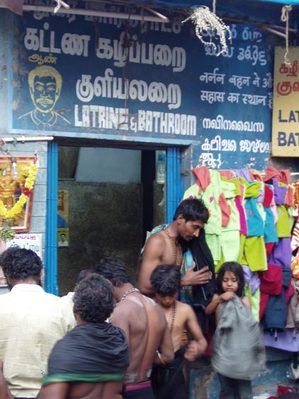 Les bains publics pour les ablutions des pélerins.
Les bains publics pour les ablutions des pélerins.
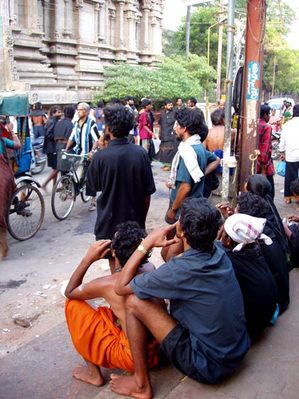 Méditations des pélerins devant l'entrée du temple de Madurai.
Méditations des pélerins devant l'entrée du temple de Madurai.
Commentaires :
Version XML - Cette page est peut-être encore valide XHTML1.1 et CSS sans tableaux.

